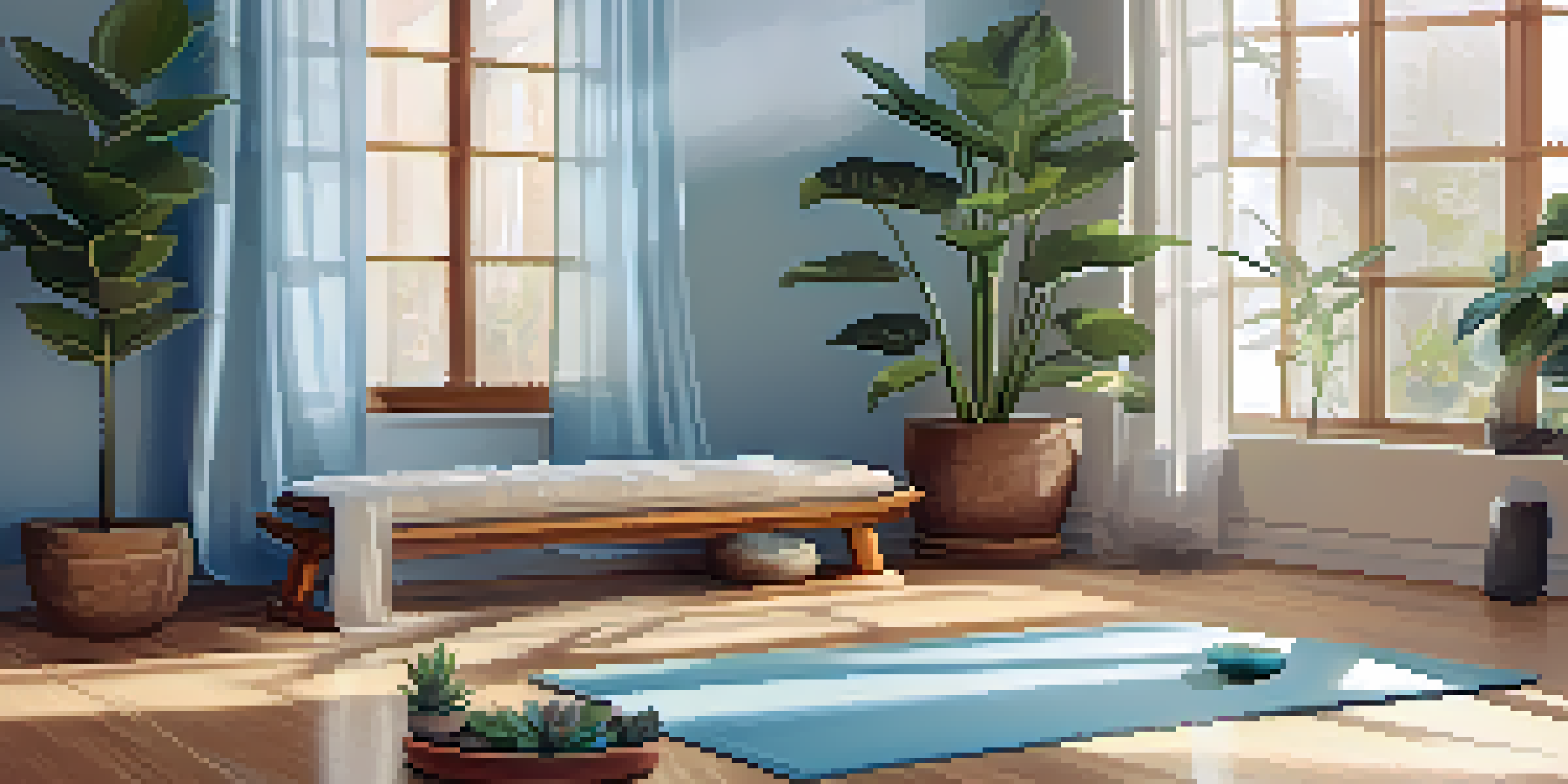Creating a Mindful Yoga Environment: Tips and Tricks

Choose the Right Space for Your Yoga Practice
Finding the perfect spot for your yoga practice is crucial. Ideally, this space should be quiet, free of distractions, and have good natural light. A corner of your living room, a spare bedroom, or even a patio can work well, as long as it feels peaceful and inviting.
Yoga is the journey of the self, through the self, to the self.
Consider the energy of the space as well; it should inspire calmness and focus. If possible, try to choose a room that you can dedicate solely to your practice, allowing it to become a sanctuary for mindfulness. You can even use a room divider to create a temporary yoga nook.
Remember, it's not about the size of the space but how you feel in it. A small, cozy area can be just as effective as a large room, especially if it reflects your personal style and promotes tranquility.
Incorporate Natural Elements for Serenity
Bringing nature indoors can significantly enhance your yoga environment. Consider adding plants, which not only purify the air but also create a sense of harmony and balance. Succulents, peace lilies, or snake plants are great options that require minimal upkeep.

Natural materials, like wood or stone, can also contribute to a calming atmosphere. Think about using a bamboo mat or a cork block to connect with earthy textures while you practice. These elements remind you of the natural world and help ground your experience.
Create a Peaceful Yoga Space
Choose a quiet, dedicated area with good natural light to enhance your yoga practice.
Additionally, incorporating elements like crystals or natural scents, such as essential oils, can elevate your mindfulness practice. Lavender can soothe, while citrus can invigorate, creating an ambiance that aligns with your intention for each session.
Set the Mood with Lighting and Color
Lighting plays a vital role in establishing the right mood for your yoga practice. Soft, warm lights can create a cozy atmosphere, while candles can add a touch of intimacy and serenity. Consider using dimmable lights or lamps to adjust the brightness according to your needs.
In the midst of movement and chaos, keep stillness inside of you.
Color is equally important; it can influence your emotions and energy levels. Soft blues and greens promote tranquility, while warm yellows and oranges can inspire creativity. You might paint the walls in calming colors or use decorative items that reflect these tones.
To further enhance your environment, think about using fabric elements like curtains or cushions in these colors. Not only do they contribute to the aesthetic, but they also create a more comfortable and inviting space for your practice.
Declutter to Promote Mental Clarity
A cluttered space can lead to a cluttered mind, making it harder to focus during your yoga practice. Before you begin, take a few moments to clear your area of any unnecessary items. This simple act can create a sense of openness and peace, allowing you to engage more fully with your practice.
Consider organizing your yoga equipment, like mats, blocks, and straps, in a neat and accessible way. Using baskets or shelves can help keep things tidy while also adding to the aesthetic of your space. Aim for a minimalist approach that promotes simplicity and calm.
Enhance Atmosphere with Nature
Incorporate natural elements like plants and earthy materials to foster a calming environment.
Remember that a clean space not only looks good but also feels good. By eliminating distractions, you can enhance your ability to connect with your breath and body, making your yoga experience even more enriching.
Create a Playlist for Your Practice
Music can significantly influence your mood and energy during yoga. Curating a playlist that resonates with your practice can help set the tone and support your flow. Choose soothing tracks that encourage relaxation, or upbeat tunes if you prefer a more energetic session.
Consider incorporating sounds from nature, like ocean waves or gentle rain, which can deepen your mindfulness experience. Many streaming services offer pre-made playlists specifically designed for yoga, making it easy to find something that fits your vibe.
Don’t hesitate to change up your music based on your feelings or the type of practice you're doing. Whether it's a gentle flow or a vigorous workout, the right soundtrack can transform your session into a truly immersive experience.
Use Aromatherapy to Enhance Mindfulness
Aromatherapy can play a powerful role in creating a mindful yoga environment. Essential oils like lavender can promote relaxation, while eucalyptus can invigorate your senses and clear your mind. A diffuser can help disperse these scents throughout your space, enriching your practice.
You can also try using scented candles or incense to create a fragrant atmosphere. Just be mindful of any allergies or sensitivities, as everyone reacts differently to scents. It’s all about finding what works best for you and enhances your experience.
Personalize Your Yoga Environment
Add meaningful decor that resonates with you to create a more intentional and inspiring practice space.
Incorporating aromatherapy not only stimulates your senses but also can anchor you in the moment. Each time you practice with a particular scent, it can evoke feelings of calm and focus, helping you establish a deeper connection to your routine.
Personalize Your Space with Meaningful Decor
Adding personal touches to your yoga environment can make it feel truly special. Consider displaying items that inspire you, such as photographs, artwork, or quotes that resonate with your practice. These elements can serve as reminders of your intentions and goals.
You might also want to include items that hold personal significance, like a souvenir from a memorable trip or a gift from a loved one. Surrounding yourself with meaningful decor fosters a sense of connection and makes your space uniquely yours.

Ultimately, your yoga environment should reflect who you are and what you value. This personal connection can enhance your experience, making each practice feel more grounded and intentional.